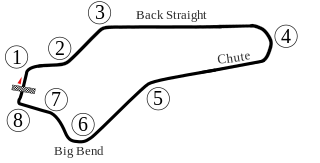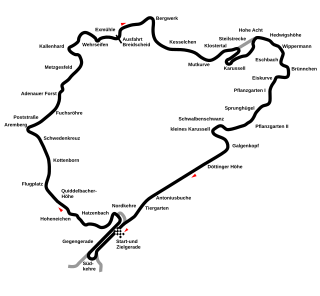Formula One World Championship results for the BRM Formula One team and BRM cars entered by other teams.
Formula One World Championship results for the BRM Formula One team and BRM cars entered by other teams.
(key)
(key)
(key)
The Surtees Racing Organisation was a race team that spent nine seasons as a constructor in Formula One, Formula 2, and Formula 5000.

The 1959 Dutch Grand Prix was a Formula One motor race held at Zandvoort on 31 May 1959. It was the ninth Dutch Grand Prix. The race was held over 75 laps of the four kilometre circuit for a race distance of 314 kilometres. It was race 3 of 9 in the 1959 World Championship of Drivers and race 2 of 8 in the 1959 International Cup for Formula One Manufacturers.

The 1960 Italian Grand Prix was a Formula One motor race held at Monza on 4 September 1960. It was race 9 of 10 in the 1960 World Championship of Drivers and race 8 of 9 in the 1960 International Cup for Formula One Manufacturers. The race was won by American driver Phil Hill driving a Ferrari 246 F1.

The 1962 United States Grand Prix was a Formula One motor race held on October 7, 1962, at the Watkins Glen Grand Prix Race Course in Watkins Glen, New York. It was race 8 of 9 in both the 1962 World Championship of Drivers and the 1962 International Cup for Formula One Manufacturers. The 100-lap race was won by Lotus driver Jim Clark after starting from pole position. Graham Hill finished second for the BRM team and Cooper driver Bruce McLaren came in third.

The 1962 South African Grand Prix, formally titled the 9th International RAC Grand Prix of South Africa, was a Formula One motor race held at East London on 29 December 1962. It was the ninth and final race in both the 1962 World Championship of Drivers and the 1962 International Cup for Formula One Manufacturers. The 82-lap race was won by Graham Hill driving a BRM, the Englishman taking his first Drivers' Championship in the process, with New Zealander Bruce McLaren and local driver Tony Maggs second and third, respectively, in works Cooper-Climaxes.

The 1964 Mexican Grand Prix was a Formula One motor race held at the Ciudad Deportiva Magdalena Mixhuca in Mexico City on 25 October 1964. It was race 10 of 10 in both the 1964 World Championship of Drivers and the 1964 International Cup for Formula One Manufacturers.

The 1966 German Grand Prix was a mixed Formula One and Formula Two motor race held at the Nürburgring Nordschleife on 7 August 1966. It was race 6 of 9 in both the 1966 World Championship of Drivers and the 1966 International Cup for Formula One Manufacturers. It was the 28th German Grand Prix and the 22nd to be held at the Nordschleife. It was held over 15 laps of the 22 kilometre circuit for a race distance 342 kilometres.

The 1966 United States Grand Prix was a Formula One motor race held on October 2, 1966, at the Watkins Glen Grand Prix Race Course in Watkins Glen, New York. It was race 8 of 9 in both the 1966 World Championship of Drivers and the 1966 International Cup for Formula One Manufacturers. The race was the ninth United States Grand Prix. It was the sixth to be held at Watkins Glen. The race was held over 108 laps of the 3.78-kilometre circuit for a total race distance of 408 kilometres.

The 1973 Belgian Grand Prix was a Formula One motor race held at Zolder on 20 May 1973. It was race 5 of 15 in both the 1973 World Championship of Drivers and the 1973 International Cup for Formula One Manufacturers. The race was won by British driver Jackie Stewart driving a Tyrrell 006.
British Racing Partnership (BRP) was a racing team, and latterly constructor, from the United Kingdom. It was established by Alfred Moss and Ken Gregory – Stirling Moss's father and former manager, respectively – in 1957 to run cars for Stirling, when not under contract with other firms, along with other up-and-coming drivers.
Gilby Engineering was a British general engineering company and Formula One constructor owned by Syd Greene.
The first table details World Championship Grand Prix results for the McLaren Formula One team. The second table includes results from privately owned McLaren cars in World Championship Grands Prix.

The BRM P261, also known as the BRM P61 Mark II, is a Formula One motor racing car, designed and built by the British Racing Motors team in Bourne, Lincolnshire, England. The BRM P261 was introduced for the 1964 Formula One season, and its design was an evolution of Tony Rudd's one-off BRM P61 car of 1963. The P261 had a relatively long racing career; variants of the car were still being entered for Formula One World Championship Grands Prix as late as 1968. During the course of their front-line career, BRM P261s won six World Championship races, in the hands of works drivers Graham Hill and Jackie Stewart, and finished second in both the Drivers' and Constructors' Championship standings in 1964 and 1965. Stewart, Hill and Richard Attwood also used works P261s to compete in the Tasman Series in 1966. The BRMs dominated, with Stewart winning four, Hill two, and Attwood one of the 1966 Tasman Series' eight races. Stewart also won the title. The works-backed Reg Parnell Racing team returned in 1967 with Stewart and Attwood, where Stewart added another two wins to his tally. In terms of races won and total championship points scored, the P261 was the most successful car in BRM's history.
The table below details the Grand Prix results for Scuderia Ferrari's factory team-entered and privately entered Formula One cars since 1950, with a separate list distinguishing between factory team entries and privateers. This distinction was particularly important in the early years of the Formula One championships.

The BRM P207 was a Formula One racing car, designed by Len Terry and constructed by British Racing Motors, which raced in the 1977 Formula One season. It was powered by a 3.0-litre V12 engine, with a claimed output of 488bhp. London-based Swiss watchmakers Rotary Watches provided sponsorship money. The car failed to score any points during the season. The team made a total of nine entries during the season, but only qualified in one instance, at the 1977 Brazilian Grand Prix. Driven by Larry Perkins, the car retired on lap one due to overheating. Its qualifying time was six seconds slower than that of the second-to-last starter. One British journalist in Brazil exclaimed that he was ashamed of being British. The car failed to appear at the season opening Argentine Grand Prix because it was too wide to fit in the hold of the aircraft that was going to transport it to South America.
The table below details World Championship Grand Prix results for the Tyrrell Formula One team. The second table includes results from privately owned Tyrrell cars in World Championship Grands Prix.

The Shadow DN1 was a Formula One car used by the Shadow team during the 1973 Formula One season and the early stages of the following season. The car was the first Formula One car for Shadow, which had previously participated in the CanAm Sportscar Series. It was designed by former BRM engineer Tony Southgate. The DN1 was also driven by Graham Hill for his privateer team, Embassy Hill.

The BRM P25 was a Formula One racing car raced from 1956 to 1960 and the second car produced by the British Racing Motors consortium. After the failure of the complex BRM V16, the P25's design emphasized simplicity. The car was fitted with a 2.5-litre straight-4 engine, producing some 275 horsepower. The P25 would be the foundation of BRM's successes in the late 1950s and early 1960s.

The Matra MS10 is a Formula One car entered by the Matra International team during the 1968 Formula One season. It, along with its V12-powered sibling MS11, was Matra's first purpose-built F1 car and won three races in 1968, taking Jackie Stewart to second place in the Drivers' Championship and Matra International to third place in the Constructors' Championship.